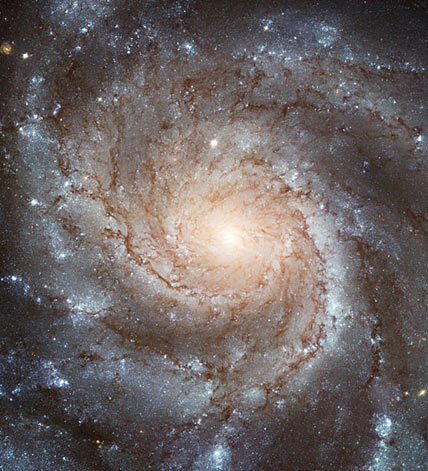Astronomy - Why Galaxies Have Spiral Arms
Astronomers have found a unique trait of spiral arms that supports a longstanding idea about where these patterns come from.

The galaxy M101 is a "grand design" spiral (meaning it's dominated by prominent, well-organized arms) of type Sc. Of its estimated trillion stars, many thousands of its brightest supergiants are resolved by Hubble.
NASA / ESA / K. Kuntz (JHU) / F. Bresolin (Univ. of Hawaii) / J. Trauger (JPL) / J. Mould (NOAO) / Y.-H. Chu (Univ. of Illinois, Urbana) / STScI
NASA / ESA / K. Kuntz (JHU) / F. Bresolin (Univ. of Hawaii) / J. Trauger (JPL) / J. Mould (NOAO) / Y.-H. Chu (Univ. of Illinois, Urbana) / STScI
Arguably the prettiest objects in space are spiral galaxies. Young, bright stars trace the arms of these graceful whorls, and dark dust lanes act like galactic eyeliner to dramatically shade them.
In principle it’s easy to make a spiral arm. For various reasons, stuff in the disk sometimes clumps together, but the clump won’t stay a clump for long: stars and clouds near the galactic center circle the galaxy faster than the material farther out does, so over time the clump gets stretched into a spiral.
However, by this reasoning, the arm should quickly wrap itself around the galaxy’s center, destroying the spiral. That generally doesn't happen. Thus for at least half a century, astronomers have debated why these patterns persist. Maybe, many have suggested, stars don’t actually create the pattern — instead, they’re just passing through it. The arms instead would arise thanks to what are called density waves. Now, observations published in the August 10th Astrophysical Journal Letters providelong-looked-for evidence that these waves do exist.
Yield to Oncoming Stars
If you’ve ever been in a slowdown on the highway, you’ve experienced a density wave. Cars whizzing down the road encounter a region where, for whatever reason, they have to decelerate. Once they’ve passed it, they speed up again. Yet even though cars are successfully passing through the jam, the slow stretch persists and keeps propagating along the highway.
The same thing happens (we think) in spiral galaxies. Even as a clump in the disk stretches into a spiral, all the stars and clouds keep moving through that arm, just as cars continue to pass through a highway choke point. Essentially, clouds and stars slow down and speed up again in a chain reaction — a density wave — that moves through the galaxy.

This diagram shows the authors' scenario for how density waves create spiral arms. The green dashed line is the co-rotation radius, where the density wave (brownish curve, labeled "stellar arm") and the stars and gas in the galactic disk travel at the same speed. Within that radius, the stars travel faster than the wave; outside the radius, the stars travel slower. In the scenario above, the density wave compresses the gaseous arm (black), which then forms new stars (blue arm) that age as they travel farther from the density wave. Those newborn stars combine with other, old-and-red stars that were already in the disk and were squeezed closer together by the wave (red). Because arms wind up with time, a galaxy's arms will look tighter or looser depending on which population of stars astronomers observe.
Hamed Pour-Imani et al. / Astrophysical Journal Letters827:L2, 2016 August 10. © AAS, reproduced with permission
Hamed Pour-Imani et al. / Astrophysical Journal Letters827:L2, 2016 August 10. © AAS, reproduced with permission
The reason we can see this spiral pattern is because as it passes through the galaxy the density wave compresses gas clouds, triggering star formation. The youngest, brightest stars will thus be nearest the wave and trace out an arm. As stars move out of the wave and spread out across the disk they will age and these biggest, brightest stars will die off, preventing the arm from totally winding up.
But that doesn’t mean there’s no winding. An important prediction comes out of this scenario: how tightly wound a spiral’s arms appear depends on which population of stars you observe. As time goes on the stars get farther from the wave, and — because the inner stars move faster and the outer stars move slower — their orbital motions do wind the arm they’re tracing, tightening the spiral over time.
But because the hot, bluish, live-fast-die-young ones kick the bucket soon after they encounter the density wave, they’ll only trace loosely wound arms. Conversely the older, redder stars will trace more tightly wound arms. So if astronomers look at a galaxy in wavelengths that pick up young stars, they’ll see a more relaxed spiral than if they look in wavelengths that pick up old stars.
Density Waves Detected
Until now, astronomers hadn’t conclusively seen this effect. But the new study by Hamed Pour-Imani (University of Arkansas) and colleagues is convincing proof in its favor. The team compiled archival images of 28 spiral galaxies in far-infrared, near-infrared, optical, and ultraviolet wavelengths. The far-infrared and ultraviolet wavelengths pick up star-forming regions, while optical and near-infrared probe older stars.
The team checked its results three ways and sure enough, it found exactly what’s predicted: arms traced by older stars hug the galactic centers more tightly than those traced by star-forming regions. The result is a neat confirmation that density waves exist.
No comments:
Post a Comment